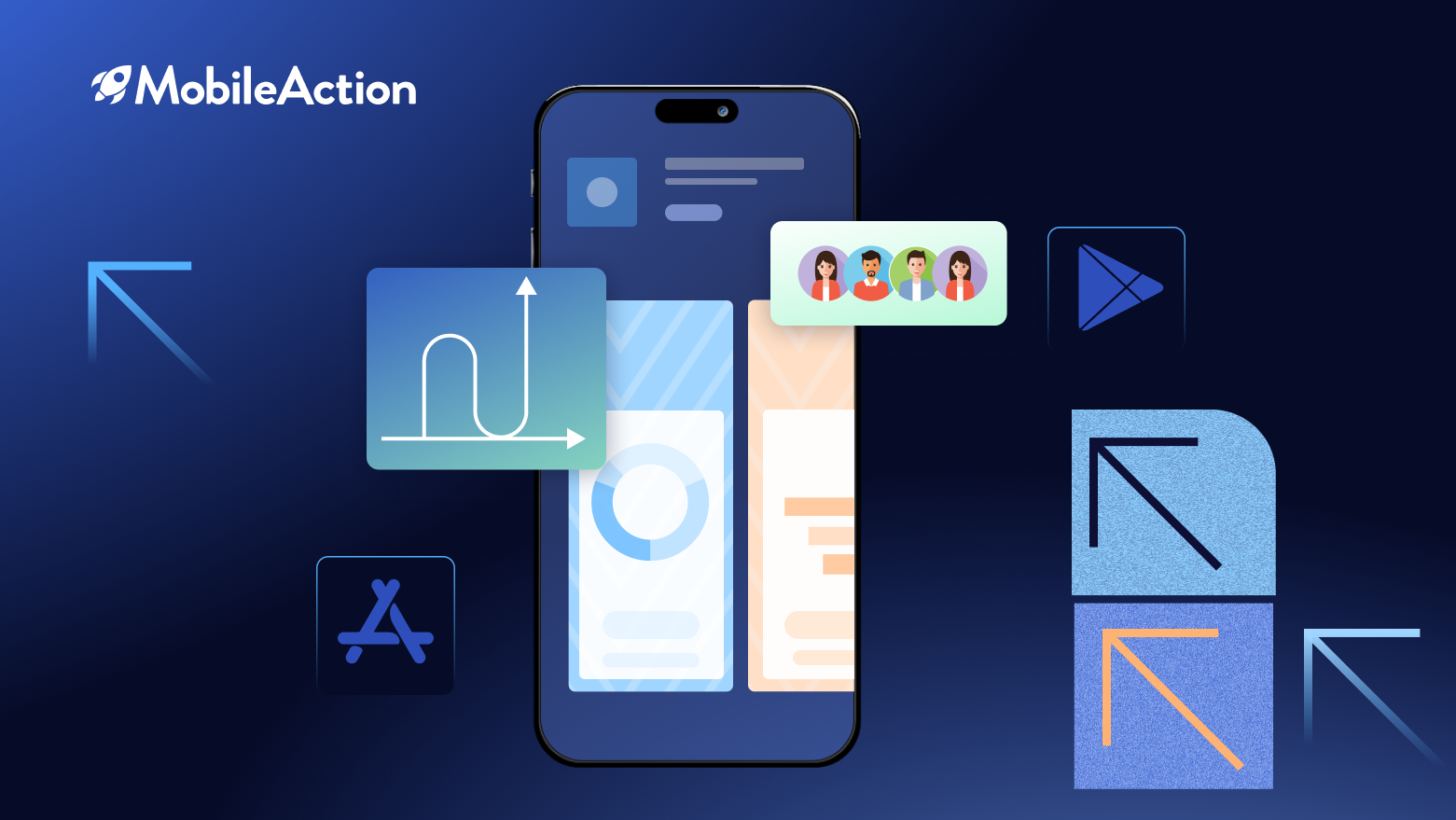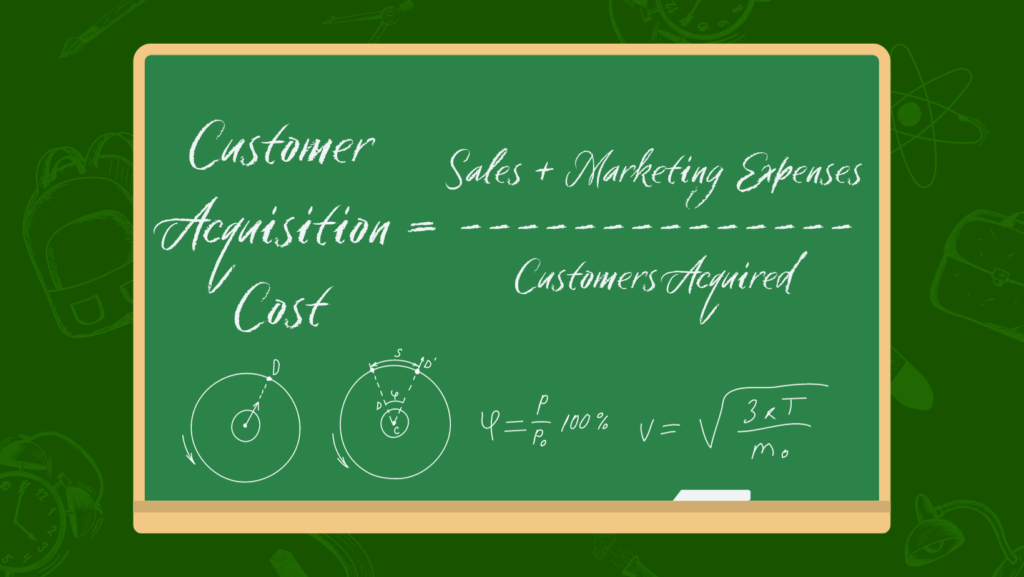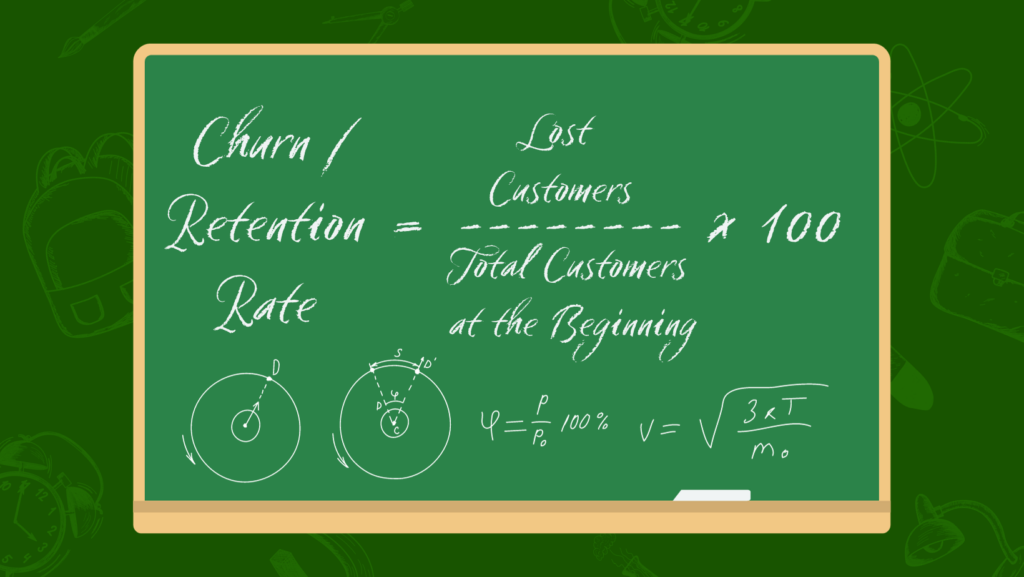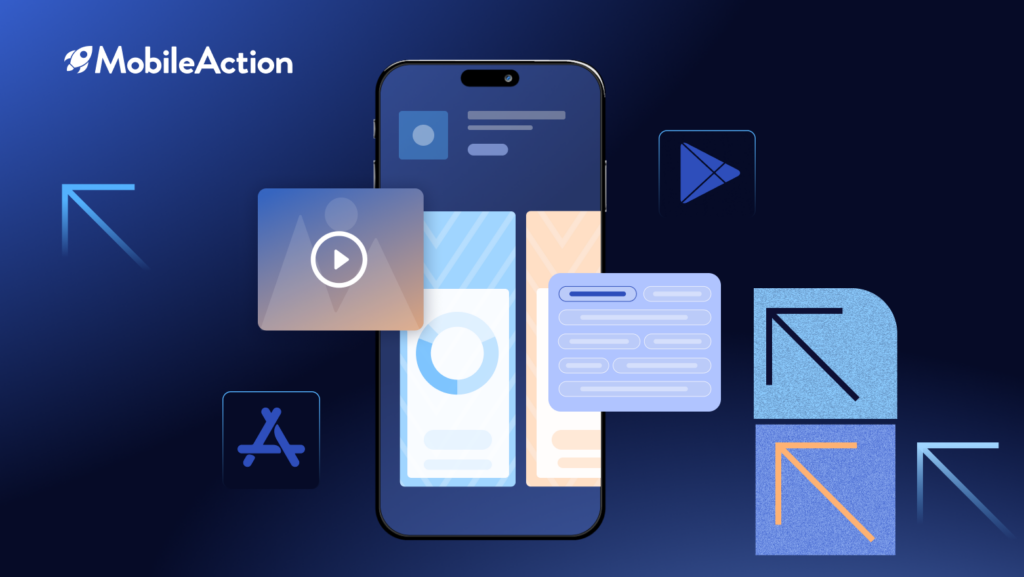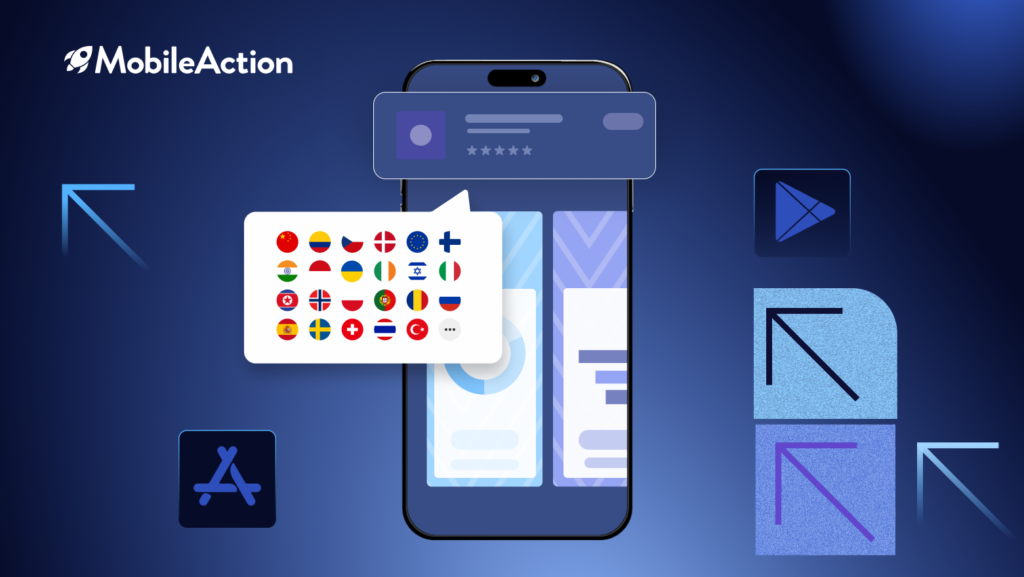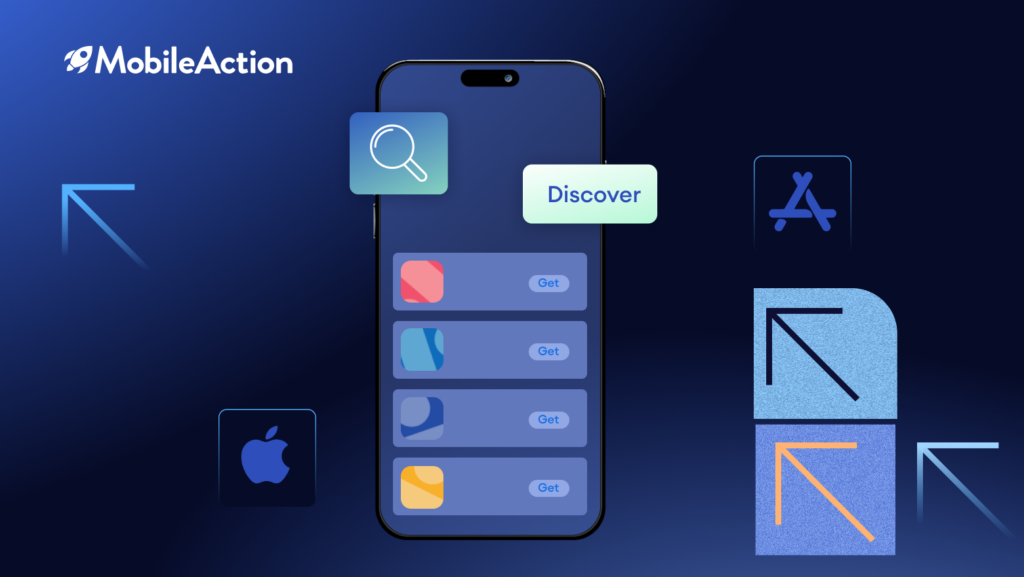Welcome to “The Definitive Guide for Mobile User Acquisition” created by MobileAction.
Whether you’re an experienced mobile marketer or just starting out, acquiring users for your mobile app or game is one of the biggest challenges.
User acquisition can make or break your mobile business.
In this guide, we will thoroughly explain what user acquisition is, dive into its importance for mobile apps and games, discuss different user acquisition channels and strategies, and provide best practices to help you acquire and retain quality users in a cost-effective manner.
Our goal is to equip you with the right knowledge to build a successful user acquisition campaign and grow your mobile presence.
We at MobileAction have helped thousands of games and apps increase their installs and engagement through our market-leading mobile user acquisition optimization platform.
Leveraging our deep expertise in running user acquisition campaigns at scale, this guide covers everything you need to know about mobile user acquisition from start to finish.
By the end, you will understand how to set user acquisition goals, choose the right channels, launch data-driven campaigns, measure success, and continuously refine your strategies.
So whether you’re just starting out or want to take your existing efforts to the next level, this guide will be your go-to resource for maximizing user acquisition.
Let’s get started on our journey of learning everything there is to know about acquiring and retaining users for your mobile business!
But first thing first, what is mobile user acquisition?
What is User Acquisition?
At its core, user acquisition refers to the process of attracting new users and customers to your product or service.
The main goal is to generate awareness about your app or game and drive installs/downloads. It can be done through paid or organic means and requires a combination of know-how, monitoring, and optimization.
Some key aspects of user acquisition include:
- Raising awareness: Telling potential users about your offering through marketing, promotions, etc. to get them interested.
- Driving installs: Convincing interested users to take the action of installing/downloading your app by overcoming barriers.
- Retaining users: Keeping acquired users engaged with your product so they continue using it on an ongoing basis.
- Measuring ROI: Calculating the return on your user acquisition investment by tracking metrics like cost per install (CPI), conversion rates, ROI, etc.
- Refining strategies: Analyzing the performance of different channels and creatives to optimize spend allocation and improve results over time.
Overall, user acquisition aims to grow your organic user base and fuel long-term usage/engagement cost-effectively. The ultimate goal is acquiring high-quality users that continuously add value to your business through metrics like retention, IAP revenue, etc.
Effective user acquisition also helps to scale your user base and better monetize development costs.
What is Organic User Acquisition?
In addition to paid user acquisition methods, organic user acquisition strategies aim to drive free traffic, referrals, and installations over the long run.
Some popular organic user acquisition tactics include:
App Store Optimization (ASO)
App Store Optimization (ASO) is the process of optimizing an app’s listing in online app marketplaces like Google Play and the App Store to improve visibility and rankings.
This involves thorough keyword research to identify relevant search terms related to the app’s topic, genre, features, etc.
The app name, description, screenshots, and video previews are then optimized to target these keywords naturally and convey the value proposition clearly.
Customizing the app listing for each store based on language, regional preferences, etc. helps as well.
Ongoing tracking of app statistics and user metrics provides insights to refine the ASO strategy over time through A/B testing of different app listing variants.
Key aspects involve regularly updating high-resolution screenshots and video previews that clearly showcase the app experience, optimizing app metadata like title and description for search and click-through rate, and addressing user reviews and ratings proactively.
Search Engine Optimization (SEO)
SEO refers to the process of improving the volume and quality of traffic from search engines like Google through organic or unpaid search results.
Major elements involve on-page optimizations like properly structuring content with relevant headings and subheadings and optimizing page titles, meta descriptions, and images by including targeted keywords.
Ensuring pages load quickly, have a logical URL structure, and are properly indexed by search engine crawlers.
Off-page factors involve link building through publishing relevant content on third-party websites, blogs, directories, etc. to pass link equity and rank for targeted keyword phrases.
Technical SEO looks at aspects like site speed, security, responsive design, mobile friendliness, etc.
Ongoing tracking and analysis through Google Search Console helps identify gaps and refine the SEO strategy accordingly based on ranking performance and keyword opportunities over time.
Content Marketing
Content marketing is the process of developing and sharing relevant unpaid content to attract and engage customers.
It aims to establish expertise and thought leadership in a particular industry or topic.
Key aspects involve thorough user research to understand target audiences and their common questions/pain points.
Developing a rigorous content creation calendar and publishing helpful articles, guides, infographics, videos, and more on owned channels like blogs and social media while also pitching as guest posts on external websites.
Utilizing SEO best practices like keyword research and optimizing content for discoverability online and on search engines.
Leveraging multimedia formatting, calls-to-action, and collecting leads/emails to convert users into the sales funnel. Tracking engagement metrics to analyze top-performing pieces and refine future content strategies accordingly.
Social Media Marketing
Leveraging platforms like Facebook, Twitter, LinkedIn, Instagram, YouTube, and TikTok involves research to understand where target audiences are actively engaged.
Creating consistent and optimized profiles with compelling headers/bios and posting relevant, educational updates.
Developing a publishing schedule adhering to each network’s optimal posting times and formats. Engaging communities through contests, questions, and responding to comments supportively.
Identifying and partnering with related influencers extends the reach of campaign messaging.
Monitoring analytics to measure engagement rates of different content formats and refine strategies.
Social media often serves as an acquisition source while also helping improve SEO through shares/links expanding coverage.
Referral Programs
Referral marketing incentivizes existing customers to recommend a brand to peers through rewards. It provides a viral organic user acquisition channel.
Key aspects involve carefully designing tiers of stacked referral commissions/discounts/virtual rewards that motivate users maximally.
Integrating friendly and simple share/referral buttons seamlessly into the product experience.
Leveraging CRM data to do customized targeting of strategic user segments most likely to refer.
Tracking referred traffic, user behavior, and ROI to optimize the program continually.
The nurturing ambassadors program fosters long-term influencers. Omnichannel promotion across websites, apps, and emails improves conversions from referrals.
What is Paid User Acquisition?
Along with organic user acquisition methods, many apps and games rely on paid user acquisition channels to help quickly scale their user base.
Paid user acquisition refers to driving installs through paid marketing activities, as opposed to free organic methods.
Some commonly used paid user acquisition channels include:
Mobile Ad Networks
Networks like Facebook/Instagram Ads, Google Ads, Twitter Ads, etc. allow bidding on mobile and desktop ads that are dynamically targeted to their massive user bases.
Testing different ad formats, creatives, headlines, and calls-to-action helps optimize results.
Precise targeting reaches users based on location, demographics, and interests inferred from user profiles and behaviors.
Networks provide insights into best practices for ad format design, bidding strategies, and granular controls for custom audiences.
Performance is tracked against key metrics like cost-per-install (CPI), with automated bid optimizations.
Attribution modeling attributes installs to specific ad campaigns and touchpoints for accurate ROI reporting.
Retargeting also extends reach to users previously exposed to your ads.
App Store Search Ads
Both Apple Ads and Google Play Search Ads enable bidding to promote your app listings at the top of the store search & browse pages.
Optimizing elements like ad creative, headline, description, and bid amount drives more relevant users to see and download your app organically.
Customizable targeting based on location, device type, and keywords ensures the right users are reached.
Campaign and keyword performance is continuously monitored against CPI to keep optimization effective.
A/B testing helps refine ad copy testing for the highest clickthrough rates.
In-App Bidding
Facebook Audience Network enables mobile app install campaigns via ad placements directly within third-party publisher apps.
Leveraging user behavior and attribute data collected within those apps drives highly targeted user acquisition.
Testing different ad creative sizes, interstitial placements and formats identifies the highest-performing mobile app install campaigns.
Integrated tracking and reporting accurately attribute installs and ROI to specific in-app ad placements and campaigns.
Affiliate Marketing
Building a specialized affiliate network provides access to related websites, blogs, and influencers for user acquisition partnerships.
Affiliates are motivated to promote your app or game through performance-based payout schemes like commission-per-install using customized tracking links.
Robust reporting and payout automation enables efficient network management and fine-tuning of commission rates by channel, referrer, and geo.
Influencer Marketing
Identifying prominent influencers across platforms like YouTube, Instagram, and TikTok with large audiences relevant to your app niche.
Collaborating with top influencers for sponsored promotions through specially coded links allows attribution of installs and ROI from their endorsements.
Ongoing monitoring helps refine future influencer selections, campaign messaging, and budget allocation for the highest-converting partnerships.
The key aspect of paid channels is they allow tapping into huge pre-existing user bases of partners like Facebook, Google, etc. to rapidly install new users – for a fee.
This fee is the cost-per-install (CPI) which varies based on channel, geography, device & other targeting factors.
With testing, one can optimize bids to achieve the most efficient CPI.
While organic efforts focus on the long-term, paid user acquisition allows supplementing them immediately to fast fuel traction and user growth through proven acquisition channels.
It’s a common strategy for quickly scaling apps and games.
Why Mobile User Acquisition is Important?
Mobile user acquisition is critically important for success due to several interrelated factors.
Firstly, mobile apps and games benefit tremendously from network effects where the value of the product increases exponentially with more users. More users engage in virality and unlock new engagement opportunities.
The acquisition helps scale this key advantage.
Secondly, for many mobile businesses, new users form the primary source of revenue through in-app purchases, subscriptions, or ad monetization. Continuous acquisition is required to fuel this revenue stream and sustain growth.
The app economies are also extremely crowded with millions of apps competing for attention.
User acquisition helps break through the saturation and discoverability challenges across app stores.
Acquiring quality users through optimized channels also directly impacts retention metrics like daily and weekly user retention that drive long-term engagement.
These engagement metrics in turn influence how investors and third parties assess the potential for a product to scale.
The acquisition process also provides ongoing feedback to enhance the new user experience design through understanding user behavior patterns at a large scale.
User acquisition efforts shape a new user’s very first impression which influences whether they remain long-term engaged and paying users or churn easily.
Finally, more users unlock the potential to test and refine various monetization experiments like monetization funnels, and cohorts analysis for maximizing average revenue per user over time.
Without continuous user acquisition, mobile apps and games cannot survive and grow their businesses in the intensive competition of app economies.
Mobile App User Acquisition
There are several unique aspects of user acquisition for mobile apps:
Fragmented platforms
Apps need to be optimized for both Android and iOS ecosystems separately due to differences in operating systems, marketplaces, device ecosystems, etc.
This involves maintaining different app store listings, creative assets, payment options, and marketing campaigns tailored to each platform.
Discovery challenges
With millions of apps across app stores, simply getting discovered organically is a huge challenge.
Unlike websites, users don’t browse app stores – they search. This places importance on search and keyword strategy to drive visibility.
High churn rates
Unlike websites, users can easily uninstall apps from their home screens or app drawers since they don’t require web browsers.
With a few taps, users can remove apps they don’t use regularly. This makes user retention far more critical for mobile apps compared to other formats.
Reliance on growth
Since apps require a steady stream of new downloads and users to be successful, user acquisition essentially becomes the main lever for the growth and expansion of a mobile business.
A/B testing acquisition channels and strategies is imperative.
Ratings and reviews impact
Early user feedback, especially reviews and ratings received within the first few days/weeks of an app release, heavily influences its visibility within search and recommendation algorithms of app stores.
It becomes important to focus on new user onboarding and support to ensure positive reviews.
Keyword optimization
Ranking at the top of search results through highly relevant keywords and keyword combinations is a primary driver of organic installs for mobile apps.
Proper keyword strategy and app name/title optimization are vital.
Ad costs
Mobile advertisers need to bid competitively across different ad networks and app stores to reach target users.
Large-scale testing is required to refine targeting, copy, creatives, and bids to acquire quality users at optimal cost-per-install values.
These factors make user acquisition uniquely challenging for mobile apps and warrant dedicated strategies, continuous optimizations, and a testing-focused approach.
User Acquisition Strategy for Apps
Developing a comprehensive user acquisition strategy is crucial to driving the right metrics over the long run. Some key elements to consider include:
Goal setting
Clearly define concrete numeric goals across multiple timeframes – such as the number of installs targeted per week/month initially to hit broader quarterly MAU/DAU goals.
Set retention and monetization metrics like LTV thresholds your acquired users need to meet.
User personas
Conduct user research and analyze your existing user data to identify the ideal user profile/persona for your app in terms of interests, behaviors, demographics, and other attributes.
Make sure your messaging, creatives, and channel targeting are tailored accordingly.
Channel selection
Evaluate both organic options like SEO/SEM, and social media as well as paid channels like programmatic & direct ad networks, and app stores search ads for suitability based on your goals, resources, and desired timelines.
Optimize budget distribution between high-potential channels.
Testing framework
Establish structured testing protocols for frequent A/B/n testing of variables like creative components, copy, ad formats, placement targeting, device/OS optimization, dayparting, etc.
Maintain test/learn loops to continually refine strategies.
Ongoing optimization
Analyze learnings and insights from data on a weekly/monthly basis to optimize budget allocation, underperforming campaigns, creative assets, messaging, channel configurations, or overall strategies as per progress on goals.
Make sure all adjustments are data-driven and aligned with overarching business objectives to maximize impact and efficiency
Measurement
Define and track key performance metrics for each campaign and channel including traditional ones like CPI/CPA as well as engagement metrics, along with tracking goals over campaigns for comprehensive analysis.
Monitor goals across campaigns for a comprehensive analysis.
Automation
Leverage marketing automation and campaign management platforms for templatized asset generation, bid adjustments based on goals, multilayered segmentation, and bidding rules for organic scaling without extensive manual effort.
Implement multilayered segmentation and bidding rules to achieve organic scaling with minimal manual effort.
Budgeting
Develop science-backed acquisition budgets that allocate funds towards sustainable growth rather than short-term vanity metrics like installs alone.
The balance between user quality, retention, and long-term value.
Partnerships
Regularly explore potential integration of newer demand sources like niche influencers, affiliates, and bundling partners for diversification and expanded reachability.
Focus on diversification and expanding reach.
This comprehensive and data-driven framework will provide clarity on user acquisition goals and priorities to optimize efforts and business outcomes consistently over time.
Mobile Game User Acquisition
There are some key unique aspects to consider for user acquisition of mobile games:
Viral Loops
It is important to design social and viral sharing mechanics within the game experience to leverage the high engagement levels of existing users.
Rewards or incentives can motivate users to share their gameplay progress or achievements with friends to spur virality.
Gameplay Videos
Potential users looking to try out new mobile games tend to prefer watching preview videos first that showcase live gameplay, graphics, and gameplay mechanics before installing.
This helps them understand if the game experience will appeal to them or not. User acquisition for games relies more on visual content than apps.
In-App Events
Regular live content updates, new seasons/chapters, and special timed events are important to keep games fresh and keep players engaged long-term.
In-app events also give motivation for lapsed users to reinstall and get back. A steady cadence of new content helps retention and replayability.
Game Genres
Different game genres tend to have varied user acquisition preferences. For example, strategy and simulation gamers may be acquired more effectively through SEO-driven organic discovery.
Whereas casual puzzle/action players heavily utilize social/paid platforms. Understanding genre nuances is important.
Cohort Analysis
Analyzing engagement and retention patterns of player cohorts segmented by their start date helps reveal any bottlenecks, hurdles, or points of decline in the onboarding process.
Insights from cohorts aid improvement of the new user experience.
Trust Factors
Compared to apps, games rely more heavily on public user reviews and ratings within app stores to address players’ higher risk perception before investing time into a new game.
Ensuring a positive onboarding experience and support is crucial.
eSports Potential
For games with strong competitive gameplay elements and communities, investments into eSports-style tournaments, and competitive streaming integrations can help increase awareness, followers, and follower-driven installs/revenues.
These efforts can boost awareness, followers, and follower-driven installs and revenues.
Ad Formats
Beyond static images, carousels, and videos; experiments with interactive/engaging demo-style ad formats that showcase gameplay tend to perform better for user acquisition of mobile games compared to regular banner ads.
These engaging formats are more effective than traditional banner ads.
This covers some of the core factors specific to optimizing user acquisition pipelines for mobile games.
User Acquisition Strategy for Games
A comprehensive strategy involves carefully planning and testing different elements:
Viral Testing
Experiment extensively with different viral mechanics like rewards for referrals, sharing levels/achievements, special game items, etc. that motivate players to share with their friends/social networks.
Track click-through rates on shared content and optimize top performers.
Video Ads
Create immersive and engaging dynamic video ads of 15-30 seconds showing actual uninterrupted gameplay.
Test different creatives, dayparts, and calls-to-action used. YouTube and Facebook tend to perform well for gaming videos.
Influencer Marketing
Partner with popular gamer influencers/streamers relevant to your genre. Provide early access to your title to produce promotional videos and livestreams.
Collaborate on content calendars.
Beta Testing
Onboard enthusiastic beta testers to play builds extensively and provide detailed feedback before the live launch.
Nurture these communities and assign testers as moderators/player promoters.
Launch Planning
Create a comprehensive launch plan involving pre-launch giveaways, beta recruitment, and launch day events/offers to drive a spike in downloads followed by consistent acquisition campaigns.
Demo Builds
Consider standalone playable game demo versions with limited levels/time to allow low commitment trials before committing to the full game download.
Demos are especially valuable for less familiar genres/games.
Day 1 Retention
Enable a stellar new player experience on day 1 with clear onboarding/tutorials, rewarding gameplay loops achieved, milestones hit and encouraged to continue playing through the day.
Cross-promotion
Look for opportunities to cross-promote between your existing games portfolio or with partner game developers to expand reach.
Strategic bundles and sequels provide additional leverage.
Community Management
Foster an engaged community on dedicated game forums, guilds, and social networks where players can help introduce new members as well as provide support and feedback as “brand advocates”.
With comprehensive testing of these elements right from pre-launch, most mobile games are able to meet their acquisition and retention objectives sustainably.
What is Mobile Advertising?
Mobile advertising refers to digital promotional strategies that reach users on portable devices like smartphones and tablets.
As mobile media consumption grows exponentially, it has become a crucial channel for user acquisition.
Some common mobile ad formats include:
Banner Ads
Banner ads are a common and straightforward mobile advertising format consisting of static or animated graphic images displayed typically at the top or bottom of mobile screens within apps or mobile web pages.
Banner ads raise awareness for brands by featuring logos and visuals with call-to-action buttons or links but often have relatively lower click-through rates than other ad types since they are routinely seen as less engaging interruptions.
Despite this, banner ads remain a staple online advertising vehicle for their simplicity and ability to target large audiences cost-effectively, making them suitable for broad branding campaigns aiming to maximize display impressions.
Interstitial Ads
Interstitial ads are full-screen mobile advertisements that display between other app interface views, such as when a user switches between screens or finishes an activity within a mobile app.
As a full-screen format that cannot be ignored, interstitial ads command the user’s undivided attention for a set duration and enable advertisers to incorporate comprehensive branding or messaging.
However, interstitials also risk frustrating users if overused, so they are best reserved for optimal touchpoints in the app experience.
When implemented judiciously, interstitial ads provide a high-impact means of delivering an ad message with ample space for visual and interactive creatives.
Rewarded Ads
Rewarded ads are a type of incentivized mobile advertising format where users are offered a small reward, such as additional virtual currency or lifelines in a game, for choosing to view an advertisement.
After accepting a rewarded ad placement, the user watches a short video or engages with an interactive ad experience before receiving the promised incentive within the target mobile app.
Rewarded ads provide a win-win scenario for both advertisers and app developers, as users receive a small perk in exchange for their voluntary attention to a brand message, generating highly engaged ad inventory with high completion rates for advertisers and new monetization opportunities for app publishers.
Video Ads
Video ads have become a ubiquitous mobile advertising format as smartphones have enabled anytime, anywhere access to online streaming video content.
Whether played pre-roll before embedded videos in apps/websites or as expandable/fullscreen ads, video engages users through motion and audio components to help boost brand awareness and message comprehension compared to static images alone.
Though video files take up more data, smartphones’ increasing connectivity and storage have made video viable at scale.
When optimized for mobile screens through shortened runtimes and vertical orientation, video ads perform well by addressing multiple senses to capture user attention in an immersive format suitable for displaying product demonstrations or narrative storytelling.
Playable Ads
Playable ads are an interactive mobile advertising format that incorporates game-like interactive elements and levels of challenge or progression.
By allowing users to directly engage with an ad through touch, playable ads aim to provide an immersive brand experience that motivates repeat engagement beyond passive viewing.
Brands partner with mobile game studios to design short playable content showcasing their products/services.
While playable ads require more development than static media, they can achieve high engagement metrics through gameplay that distracts less than passive formats.
When carefully crafted to entertain as mini-games, playable ads enhance recall of the sponsored brand through intertwined branded rewards and achievements.
Mobile ads are predominantly bought and sold through real-time bidding on ad exchanges that allow programmatic transactions between advertisers, ad networks, and publishers.
They serve as major marketing levers for both app discovery and driving in-app conversions.
How to Measure User Acquisition?
To effectively optimize user acquisition channels and strategies, it is important to closely track key metrics over time.
So if you are ready, let’s jump into the math class of mobile user acquisition:
Number of Downloads/Installs
The total number of installs/downloads is one of the key metrics to track closely.
This indicator directly shows the total amount of users that have been acquired by your app through downloading or installing it.
In other words, the number of installs/downloads reflects how many users your app has gained in total, which is a fundamental measure of your user acquisition efforts.
Monitoring this metric allows you to evaluate the reach and growth of your user base over time from various acquisition channels and campaigns.
Cost Per Install (CPI)
The cost per install (CPI) metric reflects the average expenditure required to gain one user.
CPI allows evaluation of the efficiency and cost-effectiveness of user acquisition campaigns.
Specifically, it measures the mean cost involved in acquiring a single new user through various marketing efforts like ads, affiliate programs, etc.
Tracking CPI across different channels and strategies aids in assessing which ones deliver users at a lower financial price point.
This provides insights into optimizing bids, budgets, and tactics toward driving lower-cost user gains over time.
Return on Ad Spend (ROAS)
ROAS (return on ad spend) compares the total revenue produced through advertising activities with the monetary investment devoted to those advertising activities.
It offers a means to assess the performance and success of distinct advertising channels and marketing campaigns.
By relating the revenue outcomes back to advertising expenditures, ROAS helps app owners evaluate the cost-effectiveness and profitability of specific channels, creatives, targeting, and other campaign aspects.
This metric allows identifying high-return campaigns and channels that most effectively multiply the monetary input through user acquisition.
Click Through Rate (CTR)
Click-through rate (CTR) refers to the ratio of impressions that lead to clicks expressed as a percentage.
Formats with a higher CTR are more effective at attracting user clicks on ads. CTR provides insight into which ad designs and creations spark the most user interest and interaction.
Higher performing formats in terms of CTR should receive an increased budget allocation for user acquisition campaigns since they demonstrate stronger attractiveness to users from the same advertising expenditure.
Prioritizing budget allocation based on CTR helps optimize user engagement and acquisition efficiency.
Conversion Rate
The conversion rate indicates the ratio of installs compared to total ad interactions in the form of clicks or impressions. It is calculated as a percentage.
This metric helps identify the most effective creative content and targeting approaches used in ads.
By relating installs specifically to click or impression volumes, the conversion rate enables pinpointing which ad targeting or creatives resonate most convincingly with users to generate the desired install action.
Isolating high conversion rate strategies assists with optimizing user acquisition by recognizing and emphasizing the most impactful creative and targeting techniques.
Customer Acquisition Cost (CAC)
Customer acquisition cost (CAC) is a metric that evaluates the efficiency of the overall user acquisition process. It is calculated by taking the total monetary investment devoted to user acquisition efforts during a specific time period, such as monthly or quarterly, and dividing this by the total number of new customers gained within that same defined timeframe.
In other words, CAC represents the average cost to procure one single new customer through the budget allocation for user acquisition campaigns.
Churn Rate / Retention Rate
While churn rate/retention rate is a metric that is measured after the user acquisition process, it remains an important factor to consider.
There is little benefit to gaining new users through downloads and installs if they do not subsequently engage with the app on an ongoing basis.
The retention rate measures the percentage of acquired users who continue using the app after the initial download.
A higher retention rate signifies a more effective user acquisition strategy that is successful in drawing in users who find value and keep coming back.
It indicates the ability to attract and hold the interest of users over time through a quality app experience post-download.
Lifetime value (LTV)
Like retention rates, the lifetime value (LTV) metric provides insights into users beyond the initial acquisition phase.
LTV estimates the total revenue earned from a user over the complete duration of their time spent engaging with the app.
It helps app owners determine the long-term monetary worth of gaining each new user.
LTV serves as an important measure for evaluating the return on investment of user acquisition campaigns and strategies.
By comparing LTV to customer acquisition costs, operators can assess whether acquisition efforts provide ongoing value or if optimizations are needed to improve the long-term ROI of driving new users.
Tracking these core metrics continuously allows identifying top-performing channels, ad formats, and audiences to optimize user acquisition on an ongoing basis.
Regular analyses help improve ROI and scale growth efficiently over time.
Some Tips for Mobile User Acquisition
Here are some best practices to help optimize your mobile user acquisition strategy:
Here are some tips for mobile user acquisition in more detail:
- Leverage app reviews: Encourage happy users to leave positive app store reviews which can boost visibility and conversions for potential new users browsing the app store. Targeted review requests at optimal points like onboarding can be helpful. Addressing lower-star reviews also shows responsiveness.
- Conduct thorough audience research: Spend time researching your target users to understand behaviors, demographics, interests, and pain points. Define your ideal user persona.
- Test multiple creatives: A/B tests different ad creatives like images, text, and layouts and tracks engagement metrics. Continually optimize underperforming creatives.
- Optimize landing pages/install flows: Ensure these experiences are slick and attention-grabbing and convert users seamlessly into the app. Remove friction.
- Leverage key social platforms: Identify where your audience spends the most time online through platform analytics. Heavily focus acquisition budgets here.
- Integrate tracking pixels: Use a tracking solution to accurately attribute installs and ROI to each campaign, ad creative, and network/publisher used.
- Incentivize sharing: Offer bonuses, badges, and rewards to motivate users to share your app organically via social proof marketing tactics.
- Run timed promotions: Limited-time offers, and early-access programs increase FOMO and drive referral virality within communities.
- Seek collaboration opportunities: Identify related apps/sites and seek win-win promotional partnerships, like guest posting or cross-promotions.
- Develop KPI dashboards: Quickly analyze dashboards of key metrics like CPI, ROAS, and LTV for each campaign to optimize spend.
- Refine based on drop-off insights: Use analytics to identify and remedy areas causing user falloffs like onboarding or engagement.
- Continuously test and learn: Maintaining a testing culture is key to iteratively optimizing acquisition approaches over time.
How to Acquire Users with MobileAction and SearchAds.com?
- Increase App Store Visibility: Utilize ASO and Apple Ads together to maximize your app store presence.
- Manage Your App Directly: Analyze and reply to your reviews, and update your app metadata straight through MobileAction.
- Increase Efficiency: Automatically create and optimize Apple Ads campaigns with AI-powered smart tools from keyword research to bid optimization and performance monitoring.
- Validate New Strategies: Analyze your competitors and discover what works and what doesn’t so you don’t waste your budget.
- Increase Acquisition Volume, Lower Costs: Find high-intent users who will stay loyal and ensure every dollar spent brings the highest ROI.
- Improve Keywords With Market Insights: Identify high-intent keywords and top-performing custom product pages that drive downloads for your competitors with the industry’s one and only Custom Product Pages and Search Ads Intelligence covering all ad placements.
If you need help refining your UA strategy, please do not hesitate to contact us today!
We can share tips and tricks on how to optimize your ASO and paid UA strategy, specifically for your app or game.
